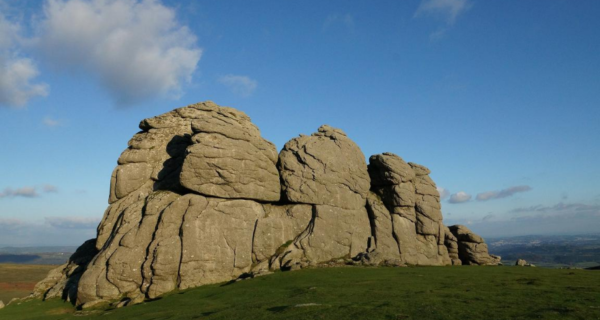“Have you seen the Jack in the Green?” asked the English Rock Band Jethro Tull in their 1977 album Songs from the Wood.
Yes, I have. I’ve seen him in numerous guises, as art, as a symbol, and in ancient-yet-living rituals, known sometimes as Jack in the Green and also by his moniker The Green Man. This is the story of one such encounter.
I’ll always remember where I was on May 1st, 2016. My wife Marsha, Friend and editor Ellyn, and I, were staying in a rambling Medieval house in Devon, England, where we were vaca-working on writing business. I was excited to be in Southern England as Beltane approached (May Day, formerly known by its Celtic name Beltane, was one of the chief festivals, the beginning of summer for the pre-Christian Celts).
On May Day morning, we started out at the magical hour of 3:30am and drove in the dark for over an hour between hedge rows, through unlit roads, arriving in the chilly pre-dawn at Haytor Rocks in Dartmoor. Dartmoor is one of the strangest, most haunting environments in England, both barren and lovely. Its desolate moors and dramatic rock escarpments seem like a Marscape at times, and Wistman Wood with its moss-covered dwarf oaks is the perfect enchanted forest. It’s no wonder Arthur Conan Doyle placed his story The Hound of the Baskervilles in Dartmoor.
Beneath the craggy granite outcropping at Haytor Rocks we gathered with a small crowd of folks to celebrate the Beltane dawn with Morris dances. The place is so isolated that the dances were done right in the middle of the road—and not a car came by to interrupt. There were three dance troupes there, with their attendant musicians. Onlookers were friends or family of the dancers. Part of the excitement being there was the sense that this was not a performance—at least not a performance for a human audience. I experienced the dances as ritual, enacted for the land, the rising sun, the ancestors.
No one is certain where we get the expression “Morris Dance.” Some suggest the word derives from the medieval word “Moorish” (Muslim), but that is by no means certain. We know these dances are older than the Reformation, because Protestants protested them—but how far back in history are their origins? Julia Somerset and other folklorists point to the Morris Dance tradition as a survival of pre-Christian rites having to do with both fertility and the resurrection of new life out of death. Some Morris dancers hold up deer’s antlers as they dance—why? No one remembers, but customs like that seem to give credence to an origin in the ancient nature religion.
One of the troupes on this May Day morning was the Beltane Border Morris group. They perform with ashes upon their faces—recalling the prominence of chimney sweeps in May Day celebrations of the 18th and 19th centuries—and wear long shredded strips of black fabric. These dancers are referred to as “crows,” recalling the very ancient connection between corvids and the ancient deities of the land; the Morrigan who shape-shifted to crow, Bran the demigod whose name means “raven,” and Wotan the one-eyed All-Father with his two ravens “memory” and “awareness.”
Their dance is combative: rows of dancers’ whirl and charge one another, screaming what can only be described as battle cries, and clashing hardwood sticks so roughly that chips fly. It’s dance, sport, and melee in one. Those folklorists who are inclined to see ancient fertility rituals in the dance will point to this as ritual combat between the forces of winter and of summertime, performed on Beltane as summer engages in climactic and victorious battle against cruel and resistant winter.
And as another Morris troupe dances, a vegetative figure strides in their midst—our friend Jack in the Green! He’s wearing a camouflage ghillie suit, designed for soldiers and hunters, and a leaf-face mask patterned after the classic foliated heads in churches, and he carries an unmistakably phallic staff. He serves as a human maypole, standing amidst the dancers whose movements swirl round about him. While his outfit is modernized, this Jack in the Green stands in the place of countless leafy ancestors who have appeared on May Day mornings in centuries past, an icon of summer greenery once again filling the land.
After the dance troupes have finished their choreographed rituals, the rest of us are invited to join the revelries. A dancer hands us hardwood dance sticks—the closest comparison I can come up with is a baseball bat—and they show us how to dance in opposing circles, whacking our sticks against one another. We enter into the dance, gingerly batting with the staffs, gleeful as we join the ancient rite.
And then, when the dawn has driven darkness off the moors and crags, the crowd disperses. The roadside that was filled with accordion music, the clash of sticks, and loud shouts, will be lonely and silent again.
As I stood in the cold dawn of Beltane morning, watching the Morris Dancers and their friend Jack in the Green, there was a palpable sense of continuity with the ancient past. Those dancers silhouetted before the rising of the sun on this chilly morning, liminal between winter and summer, seemed to echo a primordial heritage. I look into the eyes of the Jack in the Green as he seems to wink at me saying, “I am the symbol of your ancestors’ faith in the summertime renewal of the land.”
Yet there is more to the enigmatic figure of Jack in the Green. He also symbolizes a deeply Christian understanding of the human predicament. In other chapters of this book I present cogent evidence for this little-known sacred meaning of the Green Man.
—Excerpted from The Soul of the Green Man by Kenneth McIntosh, to be published in May of 2020, with permission of Anamchara Books.

